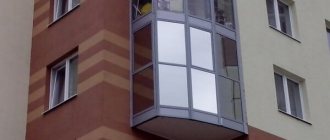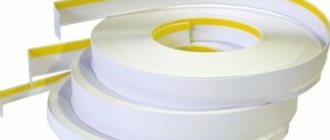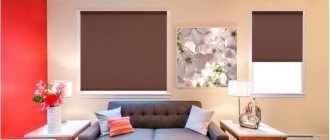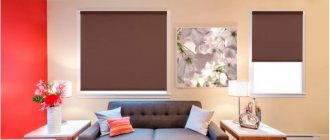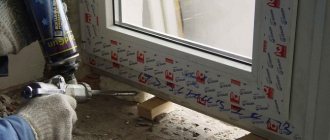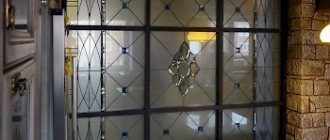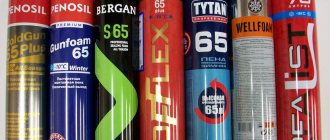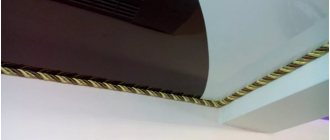In hot weather, going out onto the balcony located on the sunny side of the house is another challenge, don’t you agree? And, if on the first floors the trees growing nearby save the situation a little, then for residents of the upper floors the air on the balcony warms up to such an extent that it becomes uncomfortable to be there. The situation can only be saved by tinting the windows on the balcony, which will help protect the room from the scorching rays of the sun.
In this material we will talk about what films are used for window tinting, how to choose the appropriate option, and also how to install the film on your balcony windows yourself.
What is window tinting?
Windows are an integral part of every home. It is through them that sunlight penetrates into our houses and apartments. But sometimes there is a lot of this sunlight, which causes the air to warm up too much.
In addition, under the influence of direct sunlight, furniture and appliances deteriorate, wallpaper fades, etc. In order to avoid all these troubles, use window tinting on balconies and loggias.
Tinted windows not only look much more attractive against the background of ordinary ones, but also give the apartment’s inhabitants long-awaited coolness
Window tinting involves covering the glass with special films. At your discretion, you can choose the degree of darkening, preferring a darker/lighter option.
This service is quite expensive, but you can do the tinting on your own without resorting to the services of specialists. To do this, you will need to choose the appropriate material and do the pasting yourself, but more on that below. First, let's look at the types of tint films.
What is athermal solar film for windows?
Athermal film for windows is distinguished by a special type of energy-saving coating, the primary task of which is to ensure maximum heat retention in the room. It was the relevance of energy-saving coatings that led to the development of multilayer films characterized by the presence of several protective layers. Various ultra-thin coatings are created using rare earth and precious metals, through which the visible spectrum of light passes, but the penetration of infrared and ultraviolet radiation is reduced to a minimum.
Athermal film for windows ensures maximum heat retention in the room
The use of athermal coating reduces heat loss through window glass by 35-45% in the cold season, and in summer it protects the room from excessive heating. Thanks to these advantages of the material and the manufacturing features of the spraying, it is possible to cover windows with film located not only on the brightly lit side of the building, but also in rooms that are oriented to the north.
A significant positive property is also considered to be the creation of a special protective screen using a metallized coating, which prevents electromagnetic radiation from entering the home. In this case, the propagation of electromagnetic waves does not extend in both directions.
Higher spray density makes glass with adhesive film safer and increases the ability of windows to withstand significant loads. Many manufacturers produce a large number of protective films for windows, which have different transmission capacities - from 90-95% to complete blackout. Most often, such products can be found on balcony windows, staircases and winter gardens.
Various ultra-thin coatings on athermal film are created using rare earth and precious metals
Types of tint films
Having finally decided on the need to tint the windows, not everyone thinks about how important it is to purchase high-quality material. As a rule, they buy the first film they come across, but this is highly undesirable.
First, you need to understand what protective films are, and then finally decide on the choice of the appropriate material.
Option #1 - sun protection
Sun protection or darkening film is one of the most popular materials for tinting balconies and loggias. It is capable of blocking about 98% of ultraviolet radiation.
By covering the glass on the balcony with sun protection film, you don’t have to worry about the sun’s rays damaging your equipment or interior items
In addition to its main function - to protect the room from sunlight, this film allows you to maintain a comfortable temperature on the balcony all year round.
Option #2 - mirror
This version of the film is used to create visibility from only one side of the glass, most often the inside.
At the same time, from the street side, the effect of a mirror surface is created, thanks to which no one will see the furnishings of your loggia, the clothes dryer or the mess on the balcony.
Mirror film reflects up to 95% of sunlight and 75% of heat, thereby creating a comfortable atmosphere indoors.
Mirror film can reduce the room temperature by 6-14 degrees Celsius. In addition, it becomes a reliable barrier to UV radiation
Option #3 - shockproof
Shockproof or protective film is most often used to protect double-glazed windows by residents of lower floors. It protects the glass from chips and cracks, for example, if a small stone is thrown at it.
In addition, the shockproof film has fire-fighting properties and protects the balcony premises from direct sunlight.
Option #4 - decorative
This film option is perhaps the most diverse of all those listed. There are many colors, patterns and designs available for sale.
In addition to the variety of colors and patterns, decorative films can differ in texture - there are matte and glossy options
If desired, you can choose an option that will fit perfectly into any room design and, in addition to practical benefits, will perfectly complement the interior.
Benefits you can get by installing window film
The wide popularity of solar reflective films for windows can be explained by the large number of benefits that the user receives as a result of its use. Let's consider the main advantages of using such products.
The ability to transmit visible light, but at the same time block infrared radiation and ultraviolet radiation. All modern window tinting films work this way, although earlier versions of the materials simply darkened the windows, but did not prevent overheating. The latest technology is designed in such a way that the sticker does not absorb visible light, but the temperature in the room can be reduced in some cases by 10 degrees.
Preservation of heat during the cold season. Sun protection for windows helps to retain about 50% of the heat in the room, which indicates sufficient energy-saving properties. The principle of providing this advantage is as follows: the material from which the film is made repels infrared rays in the direction from which they come. Therefore, the heat generated in the apartment does not escape through the windows, which is especially important for houses with panoramic windows or apartments with a large glazing area.
Window tint film can reduce infrared radiation by up to 80%.
Creating a mirror layer that does not allow prying eyes to observe what is happening in the room. This property is useful for both residential and commercial premises located on the ground floors or near other buildings. In addition, the interior, thanks to the mirror tint film, is reliably protected from optical-visual surveillance devices.
Additional security. If for some reason the integrity of the window is damaged, the glass will not crumble into small fragments, but will be fixed on the glued protective film. This will avoid injuries and cuts.
Important information! Despite the fact that a window with film does not crumble into small pieces, it is still quite easy to break it from inside the apartment, which is required by fire safety standards. This is because if there is a fire in the house, windows may be the only way to escape safely.
The unique film manufacturing technology allows us to minimize the amount of incoming solar energy without significant loss of optical visibility
Features of film selection
In order not to be disappointed with the result, when choosing a tint film, be sure to pay attention to such an indicator as light transmittance . It is expressed as a percentage and the higher this value, the higher the ability of the material to transmit light.
The next thing you need to pay attention to is the color of the film . Of course, choosing the color of the film that suits the interior of the room is not so difficult, but do not forget that the color is directly related to the ability of the material to transmit sunlight.
| Film color | Transparency level, % |
| Silver | 15-50 |
| Violet | 15 |
| Gold | 15-35 |
| Bronze | 15 |
| Smoky | 20 |
| Green | 15 |
| Grey | 15-35 |
| Blue | 15-35 |
| Solar Bronze | 20-35 |
Brand and price . You should also not save on material by purchasing cheap and low-quality products. It will be money wasted. Such material will not provide sufficient protection from sunlight, and is unlikely to last long.
Therefore, it is better to give preference to well-established manufacturers. Among which are: Armolan, Professional Window Film, Sun Control, Ultra Vision, Eastman Chemical.
In today's market, the choice of tinting films is huge. Everyone can find a suitable option, but you shouldn’t save on your purchase. It's better to pay a little more and buy really high-quality products
A protective layer against scratches is also important . Most cheap materials simply do not have it, so leaving a mark on such a coating will not be difficult, which cannot be said about branded films that have reliable protection against mechanical damage.
If you live on the ground floor, it would be a good idea to purchase a protective film of class A1 - A3. With such a coating, double-glazed windows will be almost impossible to break.
Rules for gluing
When gluing tint film, you cannot neglect certain rules. Otherwise, you can damage the material itself and even the glass. It is necessary to focus on the need to maintain a certain temperature and humidity.
- When gluing the film, the temperature in the room should not be lower than +5℃ and not higher than +40℃.
- Humidity should also be controlled: in the range from 20% to 80%. During work, you need to use a water spray to create a humid environment.
- At the initial stage, carefully wash the glass surface. For best results, use detergents and a scraper. There should also be no dust on the film. Otherwise, the toning will be of poor quality.
When removing the protective layer from the film, make sure that dust and dirt do not have time to settle on it.
You can stick the tinting film both from the outside and from the inside. But so that the condition of the coating does not depend on weather conditions, it is better if it is glued from the inside of the room.
Instructions for self-tinting
To save a little on window tinting, you can do the work yourself. There is nothing complicated about this, and the tools that are needed for the job can probably be found in every home.
So, for work you will need to prepare:
- tint film;
- window cleaner;
- spray;
- microfiber cloth;
- stationery knife;
- plastic or rubber spatula (the second option would be preferable).
Having prepared everything you need, you can start gluing the glass on the balcony.
On some resources you can find information that tinting can be done both outside and inside the room. This is not entirely true. The film that is glued from the inside will last much longer, since it is not exposed to snow, rain, and is easier to care for.
Before covering windows, it is very important to thoroughly clean the glass. To clean the canvas from dirt and dust, you can use a robot vacuum cleaner for windows. Then use window cleaner, alcohol or a special product to degrease the surface.
Make sure that there is not the slightest trace of dirt left on the glass. After all, even the slightest lint or speck of dust, once under the film, can cause bubbles or peeling.
At the next stage, you need to measure the visible part of the glass and cut out a piece of glass of the required size from the film. This can be done in advance; even before cleaning the glass, prepare blanks of the required size. This will save you some time.
Next, you need to spray the surface of the glass with water from a spray bottle, remove part of the film from the protective layer and carefully apply it to one of the upper corners of the glass.
Carefully glue the film to the glass using a spatula or towel. Bubbles may appear during work; they will need to be smoothed out immediately with a spatula. Try to carefully smooth out every millimeter of the film - its service life will depend on this.
During work, it is important to monitor the air temperature in the room. So, you should not carry out work in rooms where the air temperature exceeds +35 °C, or less than +10 ºС
When all the film is pasted, check if there are any protruding edges beyond the edge of the glass. If there are any, they can be carefully trimmed using a stationery knife.
When gluing glass, you need to monitor the humidity level in the room where the work is being carried out. Too dry/humid air can cause poor adhesion of the film to the glass, which will consequently negatively affect its service life.
Positive qualities of window tint film highlighted by most users
In addition to the practical side of using solar films on windows in an apartment, one can also highlight the aesthetic component. This includes the ability to choose the optimal color of glass, which will be an excellent addition to the exterior and interior. Thanks to a large selection of shades (from silver to soft purple, blue or gold), you can choose the best option that matches the color of the roof or walls of the building.
According to reviews, sun-protection films for windows have the advantage of being able to protect expensive curtains from fading, because even high-quality textiles can lose color under constant sunlight. Thanks to the wide temperature range (from -40 to +80 °C) at which it is permissible to use the film, both textiles and furniture will have their original appearance for a long period.
If you take into account the fact that the coating protects the windows from the sun, which causes an increase in the temperature in the room, you will be able to save a little on the electricity that is spent on air conditioning. There is also the possibility of purchasing a device of lower power and operating it in energy-saving mode. The cost savings will be especially noticeable if you apply the film in an apartment or cottage with large windows or in a spacious retail or office space.
Tinting film allows you to avoid possible overheating of the room in hot weather
Most users consider the possibility of simple, self-installation to be another important advantage of solar glass film. The material can be applied to already installed windows. There is no need to remove glass, unscrew frames or purchase special tools. All that needs to be done before work is to thoroughly wash the windows with soapy water, removing excess moisture with a slime, and let them dry thoroughly. The entire installation process is unlikely to take more than a few hours. If you don’t have confidence in your own abilities, it is better to invite a specialist to do the work, which will avoid damage to the material.
Other advantages of solar control films for windows and some disadvantages
In addition to the advantages listed above, using glass film will help prevent glass fogging, which affects the appearance of the entire room, especially if there are no curtains on the windows. This is true in apartments where “crying windows” are observed in winter. An additional protective layer will prevent the glass from freezing, which is why condensation forms on the inner surface of the window.
Helpful information! Few people know that after gluing a protective layer on the glass, the harmful effects on the eyes resulting from too bright lighting are reduced. This will keep your vision normal for longer. You will also be able to use computer equipment and watch TV with greater comfort, because rays will not hit the screen.
Poorly applied or low-quality film can peel off from the glass unit
As you can see, the coating has a large number of positive qualities, the main one of which can be considered to be the protection of the room from overheating. But before buying, you should familiarize yourself with the main disadvantages, such as:
- Fragility of the material. The surface of the film is thin, which is why it is quite easy to damage, especially if you are not careful during installation.
- Excessive stickiness. In some cases, the self-adhesive film on glass can stick so strongly that it cannot be torn off even with the use of heating devices.
- Excessive darkness on cloudy days. Due to the fact that the coating blocks some of the light, you will most likely have to use lighting items more often, especially if it is cloudy or dark outside.
In general, the service life reaches 7-10 years. Here everything depends not only on the installation technology, but also on the quality of the purchased products. A poorly glued or low-quality film can peel off or has an insufficient light-repellent effect.
Advantages and disadvantages of tinted windows
The main benefit of window tinting is dimming sunlight. This is especially true when the balcony or loggia is on the south side and bright sunlight does not allow you to comfortably stay indoors.
Tinted windows allow you not to draw the curtains even on a clear sunny day. They significantly dim sunlight. In addition, if the choice is made on a mirror film, then passers-by from the street will not be able to see what is in the room
Unlike curtains, films do not accumulate dust in incredible quantities, so they do not require such careful care. To maintain cleanliness in the room, it will be enough to only occasionally wipe the windows from dust.
Another undeniable advantage of films is their durability. By tinting the windows on your balcony, you will get rid of bright sunlight penetrating into the room for a long time.
In addition to protection from bright light, the material also protects a person from the harmful effects of ultraviolet radiation, which is also important.
With the help of decorative film you can decorate any room and give it a unique “zest”.
It is also worth mentioning the fact that the tint film does not heat up from the sun's rays, but reflects them. This will help reduce the room temperature by several degrees, which is especially important on hot sunny days.
The last-mentioned advantage of tinting can also be considered its disadvantage, because in the winter season the air in the room will warm up much more slowly than in rooms with untinted windows.
Also, you should not tint windows that are located on the north side, since sunlight practically does not penetrate into such rooms.
What is solar window film made of, what functions does it perform?
In the summer, in a metropolis, the constant heat turns an apartment or house into a real steam room. Therefore, most residents are wondering how to protect the premises from the penetration of sunlight and reduce the temperature in the home. Despite the fact that reflective film on windows from the sun was first used specifically to protect a car, recently it can be increasingly found on apartment windows. The material became widespread due to the large number of advantages that car lovers identified for themselves.
In the manufacture of tint film, polyester is used, which significantly improves the strength and elastic characteristics of the material.
Today, solar protective films for windows are used not only in residential premises, but also in office buildings, shopping and entertainment centers, which have a large glazing area. The main advantage of use is that without losing the transparency of the window, it is possible to significantly increase the comfort and convenience of living or staying in the room. Another advantage is improving the appearance of the home and giving it a more modern look.
The main substance from which solar protective film is produced is polyester, and the specific properties are achieved through the application of a thin metal layer. The main materials here are:
- aluminum;
- titanium;
- nickel;
- bronze;
- silver.
Helpful advice! As a rule, manufacturers recommend gluing reflective film to windows with the metal side. This method of gluing will simplify the dismantling of the material.
Also, using the film you can create a special shaded atmosphere in the room.
Many people want to use film painted in a certain color. Such a product will consist not of two, but of three layers. The third layer will be a material that is applied under production conditions using a laminator. This technology ensures longer color retention, and the additional layer will provide better sun protection.
Modern manufacturers have made it possible to solve several problems with the help of reflective materials: some glue film to windows so that what is happening in the room from the street cannot be seen, and others purely to protect the home from the penetration of solar flow. The simplest product options can only provide room protection from the sun, while more expensive branded products prevent the penetration of ultraviolet radiation into the room, thereby preserving the surfaces of furniture and household appliances from fading and loss of color.
It is with the help of the decorative function of the coating that it will be possible to create a special shaded atmosphere, give the room coziness and, if necessary, fill it with the desired color scheme. Decorative film can be used to decorate both the facade and interior design of a room, when it is necessary to highlight or, conversely, emphasize the style of the room.
The metallized layer acts as a kind of screen for solar radiation
Recommendations for selection
The use of certain types of protective coating for double-glazed windows depends on the required characteristics of the wooden window. First, the parameters of the room openings are analyzed - their location relative to the cardinal points, number of floors. Then the possible impact of external factors is taken into account.
The protective film is installed in the following cases:
- Increased risk of glass breaking. Installed in sports, preschool and educational institutions;
- The best option for families with small children;
- Increased risk of illegal entry into the premises;
- Production and warehouse workshops.
Installation of tinting coatings is recommended for the following operating conditions:
- Increased natural light in the room. As a result, furniture and interior items lose their original appearance;
- It is necessary to ensure that there is no view from the street. Mirror coverings are installed;
- Improvement of aesthetic indicators. Using tinting film, you can create various designs and patterns.
In practice, the scope of application of additional coating is extensive. To choose the best option, it is recommended to consult with window company specialists.
How to make installation and dismantling easier
There is one option that makes it easier not so much to stick the film on the glass as to dismantle it. To do this, you need to purchase a transparent thin sheet of polyethylene terephthalate (the so-called PET sheet).
- We cut out rectangles from it to the size of the glass.
- We make two holes in the corners on one side.
- We insert strings into them and make loops.
- Then we glue the film onto the sheet using the same technology as on window glass. We get a protective sheet-curtain that needs to be hung on the window.
- We also attach two suction cups to the top of the frame in the corners.
- Hang up these tinted curtains and enjoy the coolness.
- To dismantle, simply remove the sheet from the suction cups.
This option is more suitable for home use. It is better to do a major installation on office windows.
Coating care
Window tint film requires special care. Then it will last a long time and will look perfect:
- The first rule is that you cannot wipe the glass where the tint film is installed for two weeks after its installation. At this time, adhesion of the adhesive composition and the glass surface occurs.
- Do not wash it with products containing abrasive additives or ammonia. It is better to wipe the surface with water and liquid soap or hand dishwashing detergent, and dry with a microfiber cloth.
Rubbing the film with a sponge or paper will leave scratches on it!
Window film is produced in accordance with international quality standards. Therefore, it is characterized by durability, ease of installation and numerous positive properties that improve our life.
